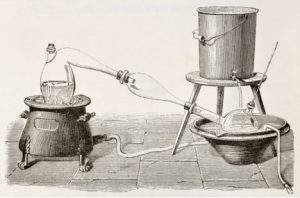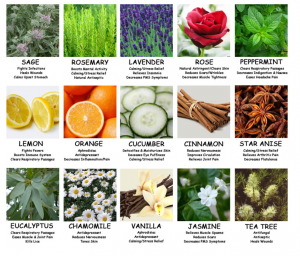
Contents
The Beauty of Essential Oils & Their Uses
What Are Essential Oils?
Essential oils are basically oils extracted from various plants : including the flowers, leaves, bark, roots, resin and peels, by various methods of distillation. The method of production/extraction determines whether the oils are cited as distilled or cold-pressed.Methods Of Extraction
Distilled Oil Method
People have been distilling nature’s plant life for centuries. Paolo Rovesti was the one who discovered an earthenware distillation apparatus which it is assumed that it was used in the production or extraction of aromatic oils using steam. In the Middle Ages, a crude form of distillation was used to extract and prepare floral waters or distilled aromatic waters. These were used in perfumes and as digestive tonics, also in cooking and general trading of commodity. #Essential_oils are basically oils extracted from various plants : including the flowers, leaves, bark, roots, resin and peels, by various methods of distillation. Share on X Even though, this use of ‘distilled’ products have been in use for a while, the oils were not really per se, ‘essential oils’; “rather they were obtained by placing flowers, roots, and other plant material into a fatty oil of best quality, submitting the glass bottles containing these mixtures to the warming influence of the sun and finally separating odoriferous oil from the solid constituents”.1 In 900 AD, Avicenna, a child prodigy from Persia who wrote many documents on plants and their uses and also instructions for massage, was accredited with refining the process of distillation by improving the cooling system. In our world today, the process of distillation is still the most common one used to extract essential oils from plants. The main advantage being that the volatile components can be distilled at temperatures lower than the boiling points of their individual constituents and are easily separated from the condensed water. The Distillation Process During distillation the plant material is placed upon a grid inside the still. Once inside, the still is sealed, and, depending upon the above methods, steam or water/steam slowly breaks through the plant material to remove its volatile constituents. These volatile constituents rise upward through a connecting pipe that leads them into a condenser.
The condenser cools the rising vapor back into liquid form. The liquid is then collected in a vehicle below the condenser. Since water and essential oil do not mix, the essential oil will be found on the surface of the water where it is siphoned off. Occasionally an essential oil is heavier than water and is found on the bottom rather than the top, such as with clove essential oil.
During distillation the plant material is placed upon a grid inside the still. Once inside, the still is sealed, and, depending upon the above methods, steam or water/steam slowly breaks through the plant material to remove its volatile constituents. These volatile constituents rise upward through a connecting pipe that leads them into a condenser.
The condenser cools the rising vapor back into liquid form. The liquid is then collected in a vehicle below the condenser. Since water and essential oil do not mix, the essential oil will be found on the surface of the water where it is siphoned off. Occasionally an essential oil is heavier than water and is found on the bottom rather than the top, such as with clove essential oil.
Types Of Distillation
There are three types of distillation: Water The plant material comes into direct contact with the water. This method is often used with flowers (rose and orange blossoms), as direct steam causes these flowers to clump together making it difficult for steam to pass through. Water and Steam This method is used with herbs and leaves. During this process, the water remains below the plant material, which has been placed on a grate while the steam is introduced from outside the main still (indirect steam). Steam This method is the most common method. During this process, steam is injected into the still, usually at slightly higher pressures and temperatures than the above two methods. Note on Boiling Point: The boiling point represents the temperature at which a liquid is converted to a gas at a specified pressure. The fundamental nature of steam distillation is that it enables a compound or mixture of compounds to be distilled (and subsequently recovered) at a temperature substantially below that of the boiling point(s) of the individual constituent(s). The oils contain substances with boiling points up to 200°C or higher, including some that are solids at normal temperatures. In the presence of steam or boiling water, however, these substances are volatilized at a temperature close to 100°C at atmospheric pressure.3 Percolation or Hydro-diffusion This is a fairly new method, yet is similar to steam distillation except that the steam comes in through the top rather than the bottom, and there is a shorter distillation time. It is useful in extracting the oils from woody or tough material or seeds such as fennel and dill. Hydrosols: A By-product of Distillation Hydrosols, also known as hydrolats, are the by-product or product (depending on the distiller purpose) of the distillation process. Hydrosols contain the water-soluble constituents of the aromatic plant and retain a small amount of essential oil. Every liter of hydrosol contains between 0.05 and 0.2 milliliter of dissolved essential oil, depending on the water solubility of the plant’s components and the distillation parameters.2 *Please Note: The addition of essential oils to water is not the same as true hydrosols. It is suggested that you read the ingredients label on products to see what you are getting – whether or not it is a true hydrosol. When water and the oils are mixed together with or without a dispersant, this is called a “spritzer” or “aromatic spritzer,” and this product should not be confused with a true hydrosol.Cold-pressed Oil Method
Another name for cold-press is expression. This method is expressly used when extracting citrus essential oils like : tangerine, lemon, bergamot, sweet orange, and lime. In earlier times, expression was done in the form of sponge pressing, usually by hand. The zest or rind of the citrus would first be soaked in warm water to make the rind more receptive to the pressing process. A sponge would then be used to press the rind, thus breaking the essential oil cavities, and absorb the essential oil. Once the sponge was filled with the extraction, it would then be pressed over a collecting container, and then allowed to stand for the separation of the essential oil and water/juice. The essential oil would then be siphoned into containers. A more modern and less labor-intensive extraction method, is the ecuelle. This process involves a prodding, pricking, sticking action to release the essential oil. During this process, the rind of the fruit is placed in a container with spikes that will pierce the peel once the device starts turning. The puncturing of the rind releases the essential oil which is then collected below the container. Most modern cold-pressing techniques are accomplished by big machines using centrifugal force. The spinning in a centrifuge separates the essential oil from the fruit juice.How Do We Use These Oils?
It is best to use essential oils with a carrier oil. The more common carrier oils are olive, coconut, and jojobaHow Many Types Are There?
There are many different types. As many plants, as are existing, is there a possibility to have an essential oil. The oils can be pure unadulterated or they can also be mixed together – a very powerful concoction.
Common Uses
Essential oils are used for various reasons:- health (as in being ingested)
- skin
- hair
- emotional treatments
- and even household cleaning.
